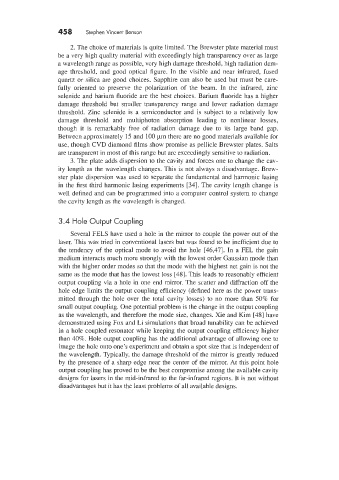Page 498 - Tunable Lasers Handbook
P. 498
458 Stephen Vincent Benson
2. The choice of materials is quite limited. The Brewster plate material must
be a very high quality material with exceedingly high transparency over as large
a wavelength range as possible, very high damage threshold, high radiation dam-
age threshold, and good optical figure. In the visible and near infrared, fused
quartz or silica are good choices. Sapphire can also be used but must be care-
fully oriented to preserve the polarization of the beam. In the infrared, zinc
selenide and barium fluoride are the best choices. Barium fluoride has a higher
damage threshold but smaller transparency range and lower radiation damage
threshold. Zinc selenide is a semiconductor and is subject to a relatively low
damage threshold and multiphoton absorption leading to nonlinear losses,
though it is remarkably free of radiation damage due to its large band gap.
Between approximately 15 and 100 ym there are no good materials available for
use, though CVD diamond films show promise as pellicle Brewster plates. Salts
are transparent in most of this range but are exceedingly sensitive to radiation.
3. The plate adds dispersion to the cavity and forces one to change the cav-
ity length as the wavelength changes. This is not always a disadvantage. Brew-
ster plate dispersion was used to separate the fundamental and harmonic lasing
in the first third harmonic lasing experiments [34]. The cavity length change is
well defined and can be programmed into a computer control system to change
the cavity length as the wavelength is changed.
3.4 Hole Output Coupling
Several FELS have used a hole in the mirror to couple the power out of the
laser. This was tried in conventional lasers but was found to be inefficient due to
the tendency of the optical mode to avoid the hole [46.37]. In a EL the gain
medium interacts much more strongly with the lowest order Gaussian mode than
with the higher order modes so that the mode with the highest net gain is not the
same as the mode that has the lowest loss [48]. This leads to reasonably efficient
output coupling via a hole in one end mirror. The scatter and diffraction off the
hole edge limits the output coupling efficiency (defined here as the power trans-
mitted through the hole over the total cavity losses) to no more than 50% for
small output coupling. One potential problem is the change in the output coupling
as the wavelength, and therefore the mode size, changes. Xie and Kim [48] have
demonstrated using Fox and Li simulations that broad tunability can be achieved
in a hole coupled resonator while keeping the output coupling efficiency higher
than 40%. Hole output coupling has the additional advantage of allowing one to
image the hole onto one’s experiment and obtain a spot size that is independent of
the wavelength. Typically, the damage threshold of the mirror is greatly reduced
by the presence of a sharp edge near the center of the mirror. At this point hole
output coupling has proved to be the best compromise among the available cavity
designs for lasers in the mid-infrared to the far-infrared regions. It is not without
disadvantages but it has the least problems of all available designs.

